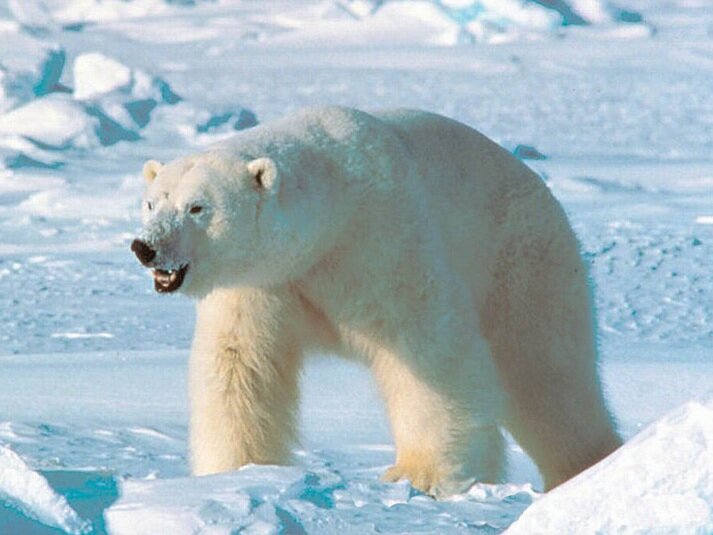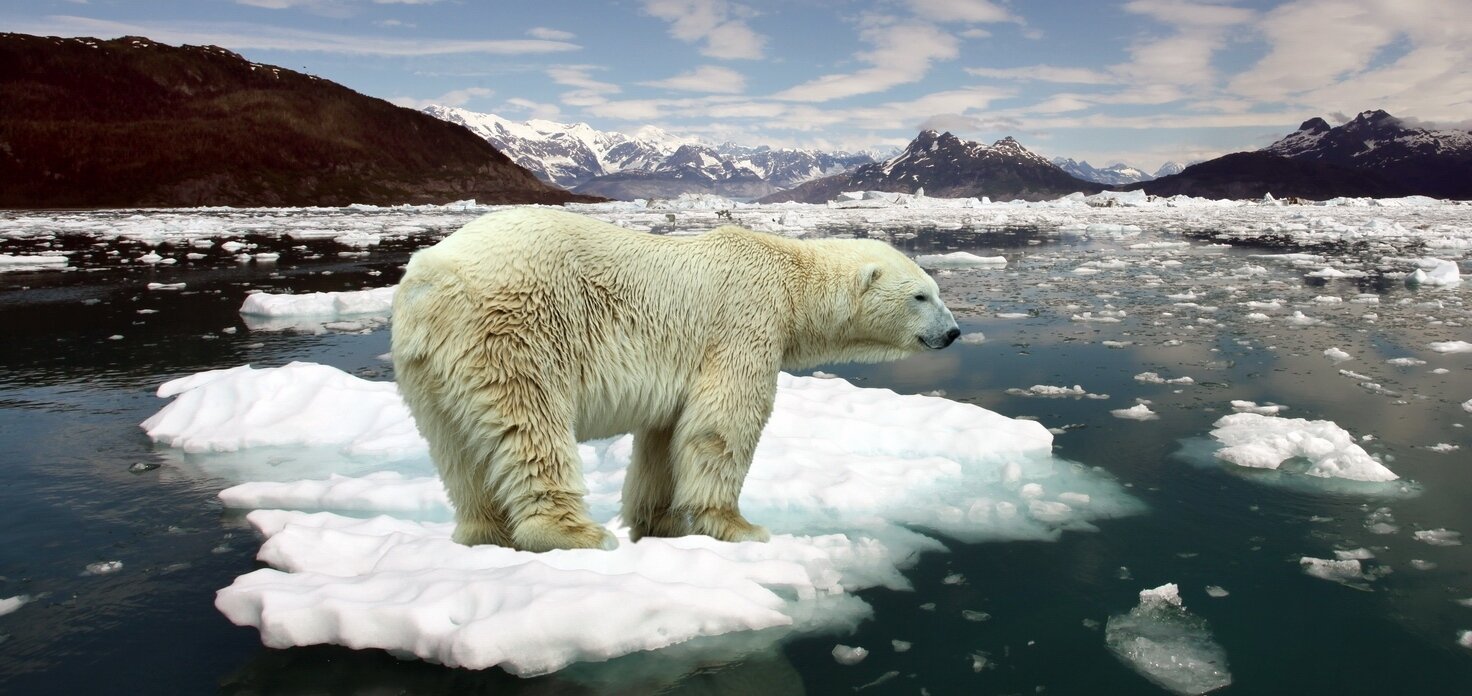Polar bear
| Latin name: |
Ursus maritimus |
| Family: |
Bear |
Белый медведь, или полярный медведь, или северный медведь, или морской медведь, или ошкуй — хищное млекопитающее семейства медвежьих, близкий родственник бурого медведя. Латинское название Ursus maritimus переводится как «медведь морской». Origin of the species Initially, it was assumed that the polar bear separated from brown about 45-150 thousand years ago, probably in the territory of modern Ireland. However, the latest study showed that the polar bear separated from their ancestor 338-934 thousand years ago (an average of 600 thousand years ago), and 100-120 thousand years ago, as a result of crossing species representatives, they hybridized, as a result Which all modern polar bears are descendants of these hybrids.
Appearance The polar bear is the largest land representative of the predatory mammal. Its length reaches 3 m, weight up to 1 t. Usually males weigh 400-450 kg, body length 200-250 cm, height at withers up to 130-150 cm. Females noticeably smaller (200-300 kg). The smallest bears are found on Spitsbergen, the largest are in the Bering Sea. White bear from other bears are distinguished by a long neck and a flat head. His skin is black. The color of the fur coat varies from white to yellowish; In summer, fur can turn yellow due to the constant exposure to sunlight. The wool of a polar bear is devoid of pigmentation, and the wool is hollow. Semitransparent hairs pass only the ultraviolet rays, giving the wool thermal insulation properties. With ultraviolet photography, a polar bear seems dark. Thanks to the structure of the wool, a polar bear can sometimes "turn green". This happens in a hot climate (in zoos), when microscopic algae are found inside the wool. The soles of the feet are lined with wool, so as not to slip on the ice and not to chill. Between the fingers there is a swimming membrane, and the front part of the paws is trimmed with rigid bristles. Large claws can even hold strong prey.
Distribution Occurs in the circumpolar regions in the northern hemisphere of the Earth. Distributed circumpolar, to the north - up to 88 ° s. In the south to Newfoundland, on the mainland in the zone of the arctic desert to the tundra zone. Lifestyle and nutrition Dwells on drifting and fast ice sea ice, where it hunts its main prey: ringed seal, sea hare, walrus and other marine animals. He catches them, creeping up from behind shelters, or near the holes: it is necessary for an animal to stick its head out of the water, as a bear pierces the prey with its paw, and drags it to the ice. Sometimes, from below, it overturns the ice floe, on which the seals are. With a walrus can cope only on land. First of all, it devours the skin and fat, the remaining carcass - only in case of severe hunger. The fishes eat up the foxes. On occasion, picking carrion, dead fish, eggs and chicks, can eat grass and algae, in the habitable places it feeds on garbage dumps. There are known cases of robbery of food depots of polar expeditions. From extraction, a polar bear receives a large amount of vitamin A, which accumulates in its liver: cases of liver poisoning by a polar bear are known. He makes seasonal roosts in accordance with the annual changes in the polar ice border: in summer he retreats with them closer to the pole, in winter he moves to the south, going to the mainland. Although the polar bear rests mainly on the coast and ice, in winter it can lie in a den on the mainland or on islands, sometimes in 50 km from the sea. In the winter hibernation, the duration of 50-80 days, there are, in the main, pregnant females. Males and single females go into hibernation for a short time and not annually. A swimming polar bear and a "spectator"
Despite the seeming sluggishness, polar bears even on land are quick and dexterous, and in the water they easily swim and dive. A very thick, dense coat protects the bear's body from cold and wetting in icy water. An important adaptive role is played by a thick layer of subcutaneous fat up to 10 cm thick. White coloring promotes the disguise of a predator. Well developed sense of smell, hearing and sight - the bear can see its prey a few kilometers away, the ringed seal can smell for 800 m, and, being directly above its nest, hears the slightest stirring. According to the memoirs of Vice-Admiral A. Smelkov, a floating polar bear, pursued by a submarine, is capable of speeding up to 3,5 knots (almost 6,5 km / h). The record fixed bearish swim was 685 km, it was over the Beaufort Sea by a bear, swimming from Alaska north to the pack ice for seal hunting, while losing 48 kg of weight (20%).
Social Structure and Reproduction Single animals. As a rule, they are peaceful towards each other, but there are clashes between males in the mating season. Adult males can attack bear cubs, mostly male. Gon from March to June. The female in the estrus is usually followed by 3-4 male. In October, females in the coastal snow deposits dig a den. The she-bears have favorite places, where they collectively gather for puppies, for example about. Wrangel or the Land of Franz Josef, where each year there are 150-200 lairs. Bear cubs occupy lairs only in the middle of November, when the latent stage of pregnancy ends. The entire pregnancy period is 230-250 days; The cubs appear in the middle or end of the Arctic winter. The female remains in hibernation until April. The battle of polar bears (Canada) The polar bears have a low reproductive potential: the female first brings offspring at the age of 4-8 years, gives birth once to 2-3 and has cubs in 1-3 litter, thus, 10-15 cubs. The newborns are helpless, like all bears, and have a mass from 450 to 750 gr. Through 3 month the female together with them leaves the den and passes to the stray lifestyle. Tedders remain with her until 1,5 years, all this time, the bear feeds them with milk. Mortality among cubs reaches 10-30%. Life expectancy is a maximum of 25-30 years; In captivity the longevity record is 45 years. Polar bears are able to interbreed with brown and give fertile (capable of producing offspring) hybrids - polar grizzlies. There is a case where a polar bear female swam more than 420 miles (685 kilometers) by the icy waters of the Beaufort Sea north of Alaska. During her nine-day swim, the bear lost her one-year-old cub and lost a lot of weight. The movement of the animal was followed by a GPS beacon attached to it.
Protection It is listed in the Red Book of Russia. Slow reproduction and high mortality of young animals make this beast easily vulnerable. However, now the population is considered stable or even growing. At 1993, it was evaluated in 21 470-28 370 individuals. In Russia, there are 5-7 thousand polar bears, and annual poaching is from 150 to 200 individuals per year. Due to the decrease in the population of Dixon, the extermination of the polar bear is slightly reduced. In the Pleistocene epoch about 100 thousand years ago, a larger subspecies giant white bear lived, which was much larger in size.
|
|







